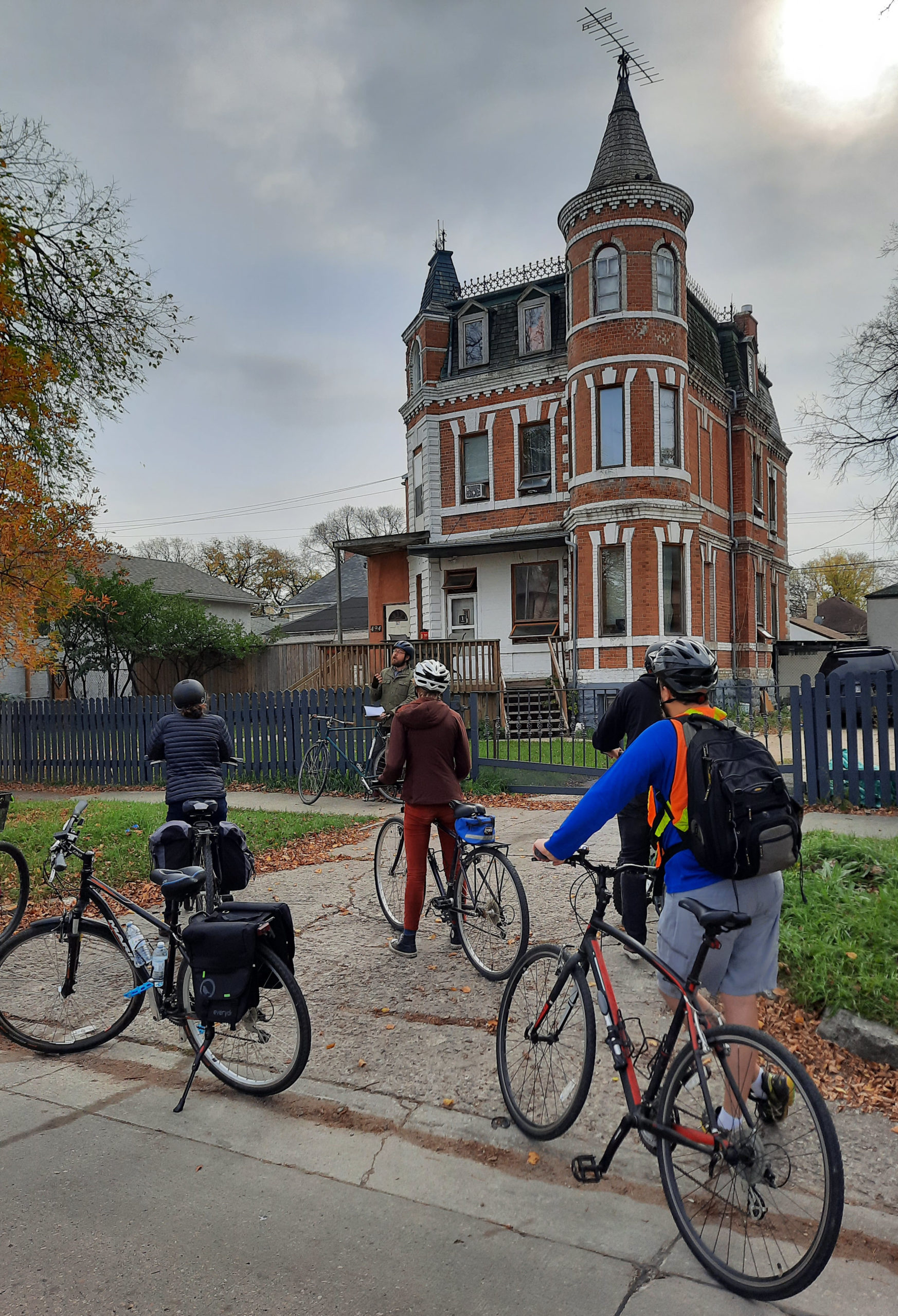
Starts: St. John’s Park
Tour Length: 8.25 km return
Introduction
We’ll be tracing the history of our city’s early elites: Visiting corrupt land barons, abusive mayors, and a wealthy Metis
Winnipeg’s North End has a reputation for being tough, but it’s also home to a fierce community pride. This area was literally on the wrong side of the tracks from our urban core, and the symbolic barrier created major social divides that are still felt today.
The North End has also been a mosaic of cultural diversity from its earliest days. Out of the early foundations laid by Jewish, Polish, and Ukrainian immigrants, the community has developed a unique identity that has given birth to strong political and social movements. The area’s historic architecture will help us trace the evolution of this identity as the community changed and spread north into the affluent suburb of St. John’s.
Tour Stops
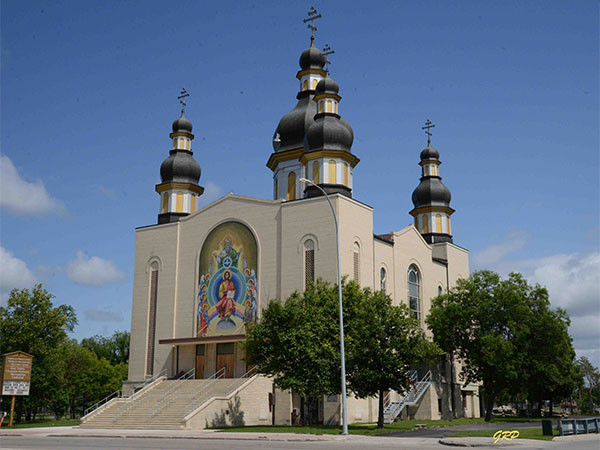
Many people see Winnipeg’s North End as the “wrong side of the tracks” – an economically depressed and even dangerous area. The reality is that it’s a rich mosaic of diverse cultures, coming together to create a very distinctive neighbourhood character. Generations of immigrants have brought their own traditions, working to build a thriving community in the face of discrimination and social marginalization.
As the title alludes to, the railway served as both a uniting and dividing factor in our city. It played a central role in the story of colonization and immigration, and even today acts as a symbolic barrier.
A Slavic influence is very evident in the area: Ukrainian & Polish names feature prominently, reflecting the people who built this neighbourhood around the turn of the 20th century. At the same time, the face of the community has constantly evolved and changed as immigration patterns shift.
We’re standing outside of Holy Trinity Ukrainian Orthodox Cathedral, built in 1962. The interior is filled with astonishing murals and icons to match the ornate front – all of which were seriously damaged and re-painted following an arson in 2016. Orthodox religious architecture makes use of these distinctive ‘onion domes’ – a very different look than the Catholic style of architecture that’s much more common here.
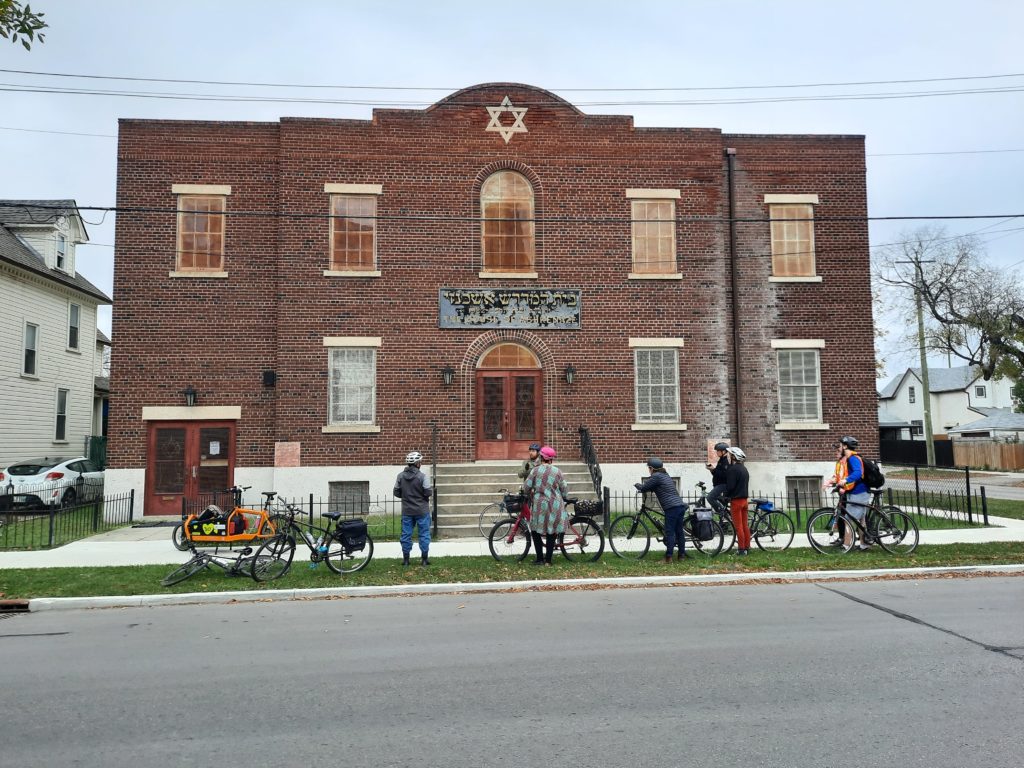
The House of Ashkenaze is the oldest extant synagogue in Winnipeg: Services have been held here since 1922. The original building was lost to a fire in 1948, and the current one was re-built the same year. Its solid brick architecture fits in with the rest of the neighbourhood and is very modest for a religious building, with little ornamentation other than the Star of David. At the time it was rebuilt it was one of a dozen synagogues in the North End; today it’s one of two.
The Jewish community played a very prominent role in the North End: The early community immigrated in the late 1800s along with other Polish and Ukrainian people. Jewish communities faced serious discrimination in the years leading up to the Second World War, as refugees were refused a home here. Attitudes softened and immigration significantly increased in the years after the war.
The community has largely moved out of the area and into the south end as their wealth and social status increased. Their impact is still left on buildings, social institutions, cemeteries, and local culture. Many of the iconic North End foods have their origins in Jewish delis serving rye bread and kosher pickles.
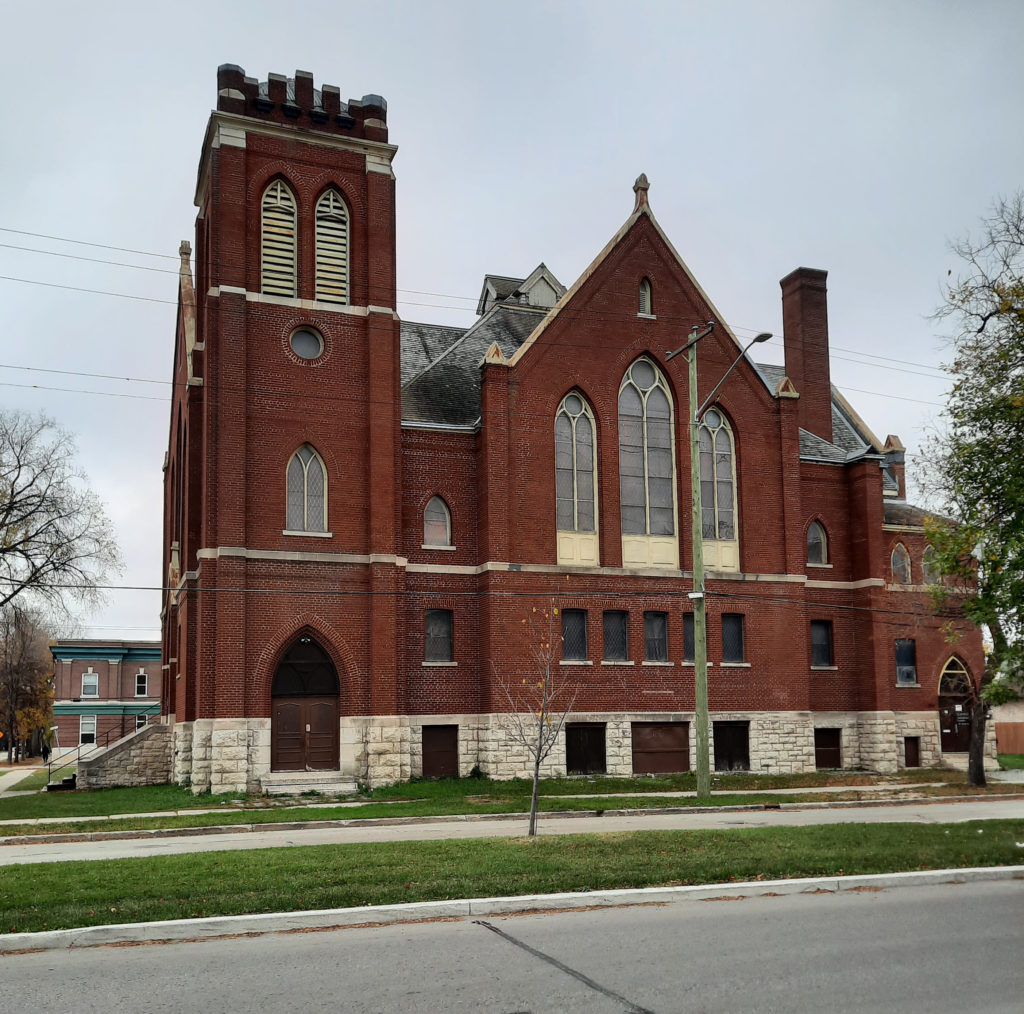
The building across the street originally housed St. Giles Presbyterian Church, a group formed in 1884 in a wood shanty nearby on Main St. In late 1884 they built a new “mission” church on Selkirk Ave, which was later converted into a theater and has now been converted back to an evangelical mission church.
This church was built in 1906 and designed to seat an astonishing 1,100 worshippers. This number tells us something about the critical role churches played a hub for community and even social services. Dwindling attendance and a reduced community significance has left many of these massive buildings changings hands repeatedly in recent years.
By the 1920s it had become a United Church, in the 1970s it became a Mennonite church, and in the 1990s it was bought by an Aboriginal Baptist church. In 2015 that church asked the City to de-list this heritage building so that they could demolish it. After opposition it was instead purchased by an active Muslim community, who are currently working hard to repair and restore the building. It is now called the Salaam Masjid.
Churches like this are one of the most obvious examples of the way shifting immigration patterns have changed the face of the area in a repeating cycle over the past century.
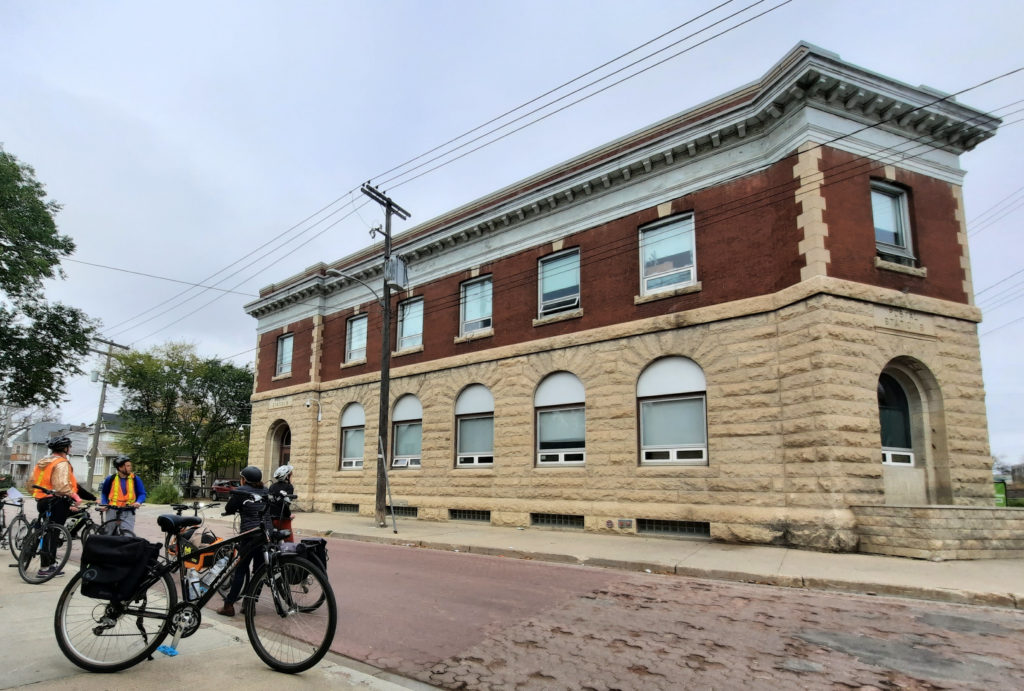
The North End Post Office (later called Winnipeg Postal Station B) was built in 1907 for $55,000. It was used for local postal service and housed various federal offices until the 1990s. It has now been converted into transitional housing for recently-released federal inmates, explaining its non-descript appearance. The public entrance along Main Street was bricked up at this time.
It’s hard to believe that 100 years ago this was the hub of a bustling commercial area in a thriving community. A few blocks away near Dufferin Avenue was the Main Street Market. It sat behind Mount Carmel clinic, where even today there is a very large neighbourhood-like housing project, rather than fully developed streets. This was the real melting pot in Winnipeg: Photos from the turn of the century show us a scene that could easily be New York or Chicago, with babushkas as far as the eye could see. Market gardeners travelled in from out of town, filling a massive square with produce and cheap goods to supply the nearby residents. The Market played a critical role because the community was virtually cut-off from accessing amenities in downtown Winnipeg before the underpass at Higgins & Main was built.
Take note of the unusual cobblestone street next to you on Magnus Ave. Have you seen anything like this outside of the Exchange District?
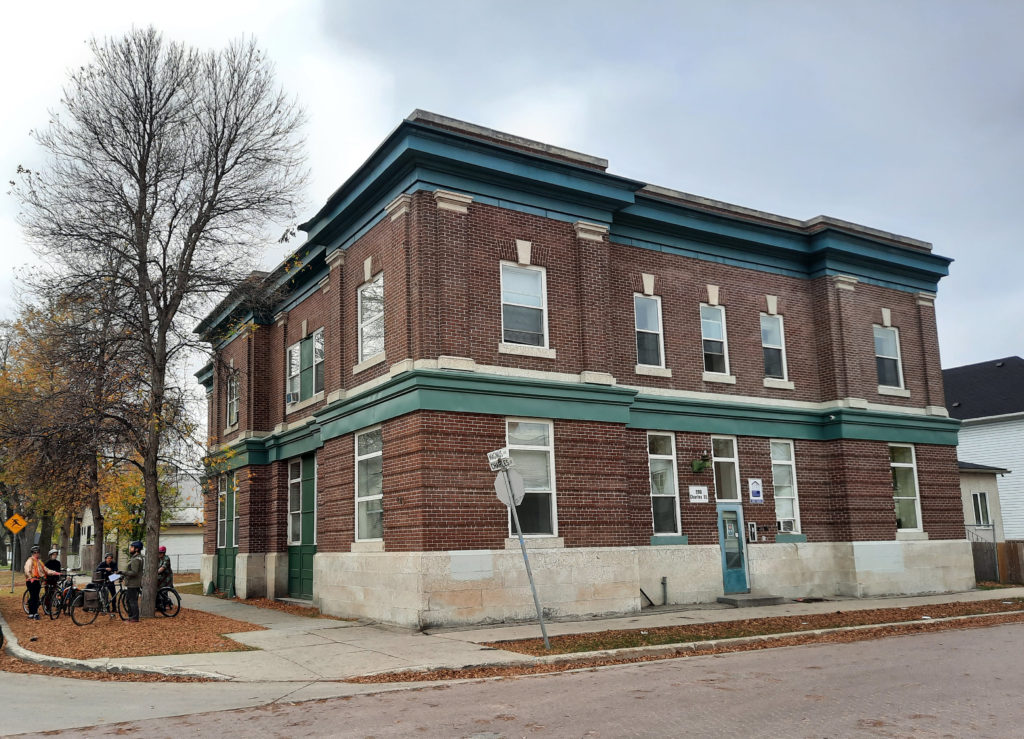
You just followed the only cobblestone road in the North End: It leads from the community’s Post Office to the former North End Police Substation, ending at Salter St. It’s not clear if this was intended to be a ‘main strip’ running parallel to Selkirk Ave, but it’s unique and certainly not accidental. It suggests a kind of Biz-style community redevelopment plan: The city finally decided to invest in infrastructure for the North End, to develop the neighbourhood beyond its rough beginnings. They built this station in 1911, expanded water and electrical service, and even brought streetcar service north. Unfortunately the investment was not sustained, and the neighbourhood’s potential was never fully realized. Today the building is used as apartments.
The railway arrived in Winnipeg in the 1880s, and our population exploded. Massive numbers of immigrants travelled from eastern Canada — coinciding with the beginnings of immigration from Central & Eastern Europe. This allowed the establishment of Slavic farming communities across the prairies — but that same railway also cut Winnipeg in half. Shanty-towns sprang up filled with thousands of new arrivals almost overnight. Areas near the tracks, like the once-affluent community of Point Douglas, experienced a major flight towards new “suburbs”.
The Higgins underpass was built in 1904. Before this time there was just an uncontrolled track crossing. Winnipeg’s role as the “Gateway to the West” meant that rail traffic hardly ever stopped, holding up commercial vehicles and pedestrians. Services like sanitation and electricity were too difficult to move across the tracks, and there are even reports of people freezing to death while waiting to cross. This area of the North End became notorious for raging typhoid epidemics and brutal squalor.
In some ways this environment planted the seeds for a distinct North End identity and ‘regional’ culture within the city. This area became a place where marginalized groups (which were not broadly accepted by the dominant Anglo-Canadian culture) could begin new lives and build their own communities. At the same time many of these people faced adversity, and the area continues to suffer from poverty. As a result, many of these communities seem to leave the area for more affluent suburbs as their economic and social status change. The faces may be different, but the story repeats itself.
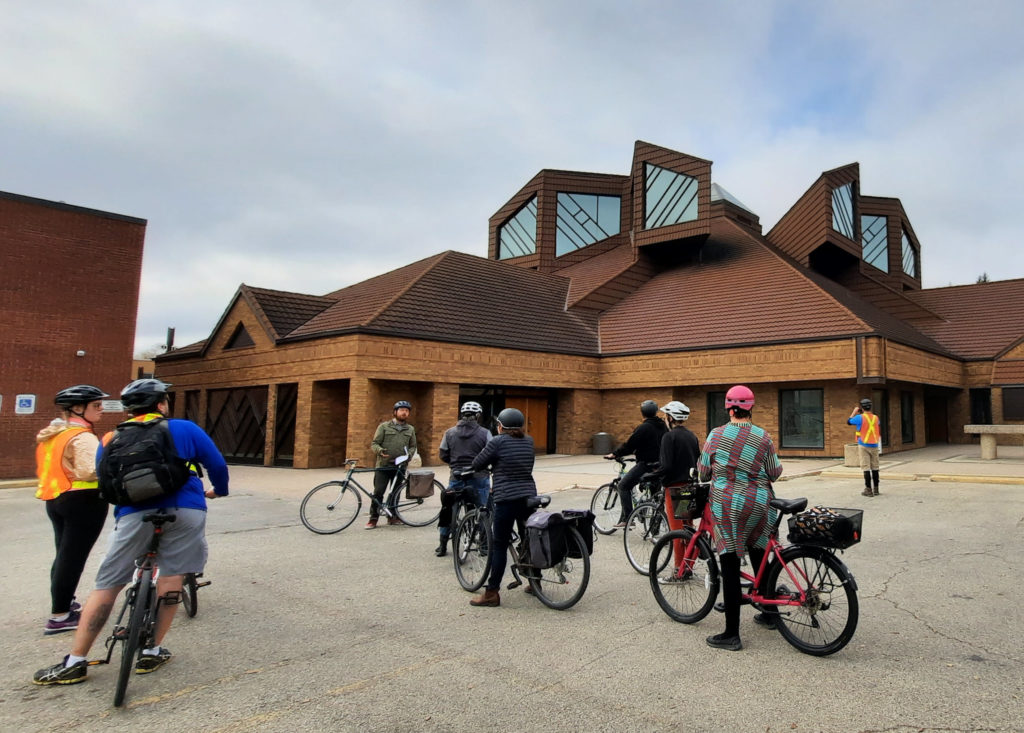
The first Polish parish in Manitoba was founded on this site in 1898 by the Archbishop of St. Boniface to serve “Poles, Ukrainians, Germans and Slovaks in Winnipeg’s North End”. A Gothic-style church was built out of wood in 1899 and became home to the first Polish school in Canada in 1902. This school made Winnipeg a hub for the Polish diaspora, and we are still host to one of the largest communities outside of Poland. Unfortunately the historic church was demolished in 1986 and replaced with the present structure, which has a distinctive modernist-inspired design.
While the community has now largely moved out of the area, Holy Ghost still serves as one of the main Polish churches in Winnipeg. Polish grocery stores and travel agents are still prominent along Selkirk Ave.
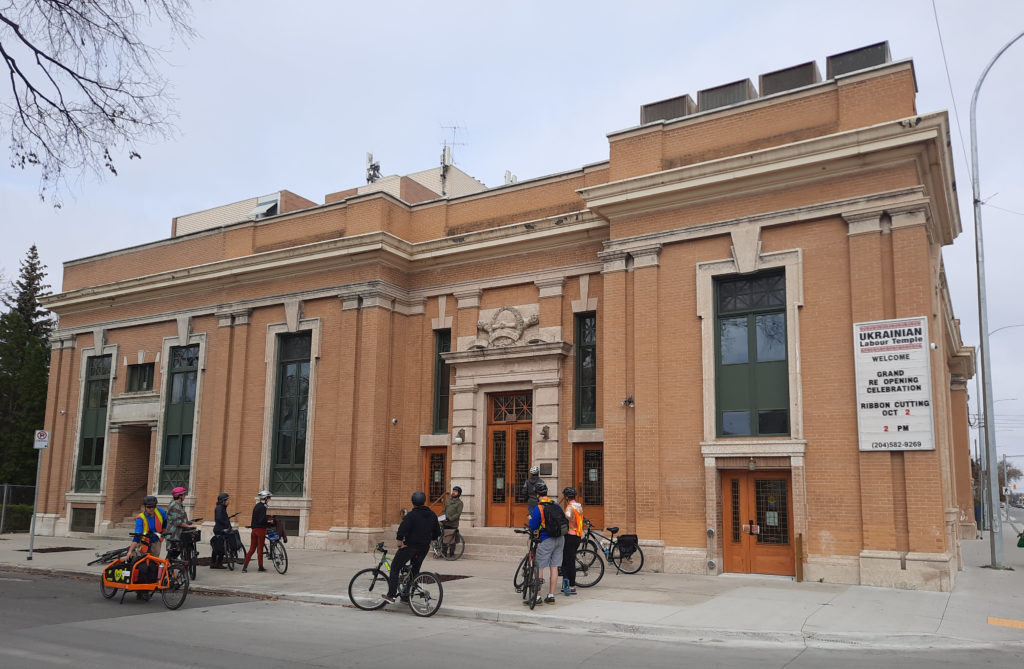
The North End has always been a hub for social activism, and this building was built specifically for that purpose. The Ukrainian Labour Temple was built by volunteers in 1918, with an auditorium that seats 1,000, classrooms and a print shop.
Its design and name were almost certainly intended to reference the imposing church architecture we’ve already seen. In socialist thought, labour organizations represented a new hub for community structure and services, taking the place traditionally held by churches. They promised empowerment and improvement for people in this lifetime, instead of the next.
The Labour Temple became an organizing site for desperately poor workers who agitated for fair wages and human rights, in the face of incredible exploitation. Their activism culminated in the 1919 General Strike, and labour halls like this across Winnipeg became rallying points and soup kitchens for strikers. The fact that these ideas seemed to originate with the recently-arrived Slavic communities was used to fuel racist policies aimed at excluding “un-Canadian” and “Bolshevik” elements from society.
These labour temples were common across the country until 1941. With tensions mounting during WW2, the Canadian government closed every temple and seized all of their property without compensation. This included printing presses used for ethnic-language newspapers, books, musical instruments and cultural items. The collectively-owned and assembled print shop here was sold to a private nationalist publisher, who became wealthy. The temple’s leadership was even sent to an internment camp. Parallel Polish labour organizations also existed, but apparently they were never subject to the same repression.
This is the only Labour Temple that survived this persecution and has continued to operate. They recently celebrated their 100th anniversary, and have just completed a massive campaign to restore the historic interior.
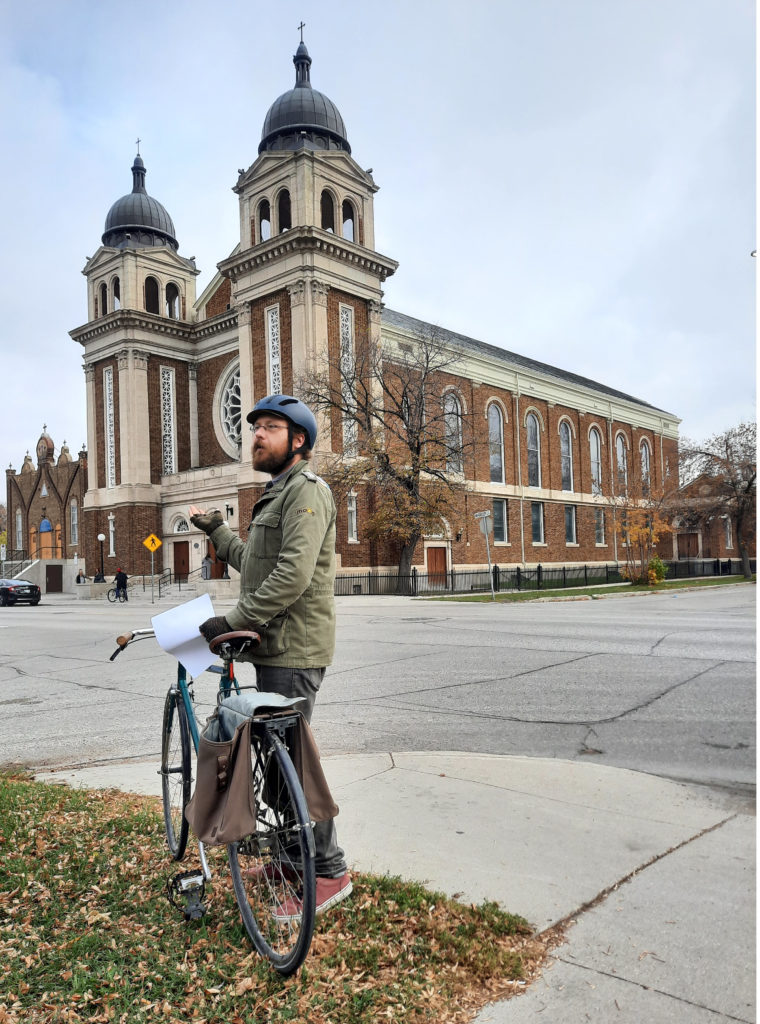
Work started on the Cathedral in 1947, but wasn’t finished until 1951 due to material shortages following WW2. Half of its incredible stained glass windows were designed by Leo Mol, Manitoba’s most famous artist of Ukrainian background. In contrast with the Orthodox dome-style cathedral we started at, this represents the Ukrainian Catholic tradition. These kinds of internal divisions within communities aren’t always well recognized by outsiders, but they have significant impacts: A simple example would be the multiple Ukrainian & Polish Folklorama pavilions, each with different dance traditions.
Contrast the architecture here with what we just saw at the Labour Temple. They’re both towering monumental buildings, both intended to inspire and awe attendees with their power.
One of the first meeting places for the Ukrainian community was called the Tin Can Cathedral, built in 1904 near the North End Market. It was a haphazard construction of scrap wood and tin roofing, covered with dozens of crooked, hand-made crosses. It was established and run briefly by a rogue “Bishop” who had no real church authority. He built up a congregation of 60,000 people before he was deposed for his alcoholism and numerous “indiscretions”. The Tin Can Cathedral was destroyed by vandals, and the community began building more traditionally established churches.
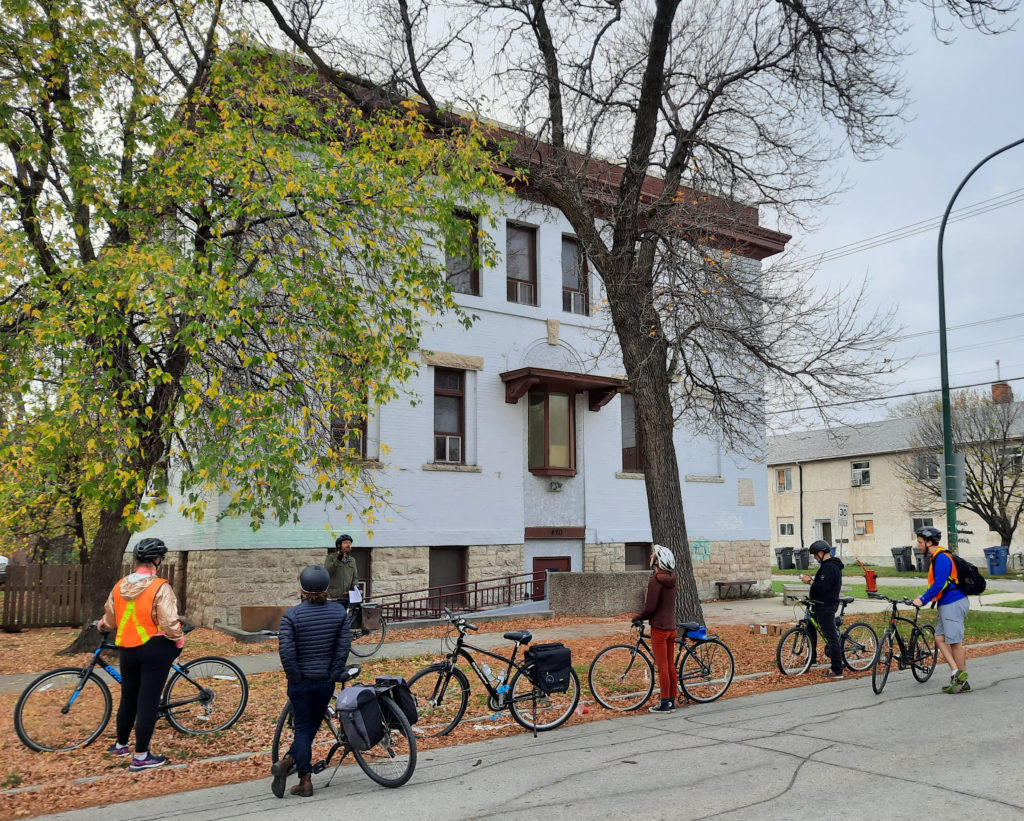
This building was constructed in 1909 to house the All Peoples’ Mission. Its founder, J.S. Woodsworth lived in the nondescript home next door from 1910-12. In wealthier parts of society, the churches continued to dominate in opposition to labour organizations. Addressing issues like poverty was seen as a matter of charitable work and spiritual education, rather than social change. Organizations like Woodsworth’s mission provided safe housing, health services and education in impoverished neighbourhoods. Unfortunately some groups also treated the poor as less-than-human. Woodsworth was a strong supporter of eugenics, producing books where he discussed a “hierarchy of races” and ranked the value of people from different ethnicities. He believed that his duty as a White Christian was to uplift “lesser” people who were incapable of helping themselves.
Woodsworth later went on to become an influential politician in the labour movement, founding a party which would grow into the New Democratic Party. He is still commemorated as the NDP’s spiritual founder and is commemorated on Broadway’s Woodsworth Building, in spite of his frightening beliefs. Today his mission is used as apartments.
The Steiman Block was built in 1913 to house a hardware store and furniture company, which became the Merchant’s Hotel in 1933. Over the years it became known for its extremely tough and dangerous bar (“The Dirty Merch”), which was a hub for drug activity. The hotel was eventually closed in response to community complaints and purchased by the province for redevelopment as a community hub. It’s now home to affordable housing units and a satellite campus for the University of Winnipeg’s Urban & Inner City Studies program.
In many ways it represents a triumph of community organizing and revitalization in the North End. Selkirk Ave was historically the community’s commercial centre; its actual Main Street. Today it’s often seen as one of the most dangerous areas in the city and is filled with vacant businesses. Community efforts like “Meet me at the Bell Tower” and the Merchant’s Corner have worked to channel community pride into action and improvement.
The same railway that gave birth to this neighbourhood brought incredible disruption to Indigenous communities, which were forced onto reserves in the 1880s under the Pass System. This system was used until the 1930s to prevent Indigenous people from leaving their reserves, under threat of punishment by the RCMP. When the system was abolished, people started to move to urban centres like Winnipeg looking for work. Arriving in areas like the North End they were, and continue to be, subjected to tremendous discrimination and marginalization. In many ways, the neighbourhood’s story continues to repeat itself.
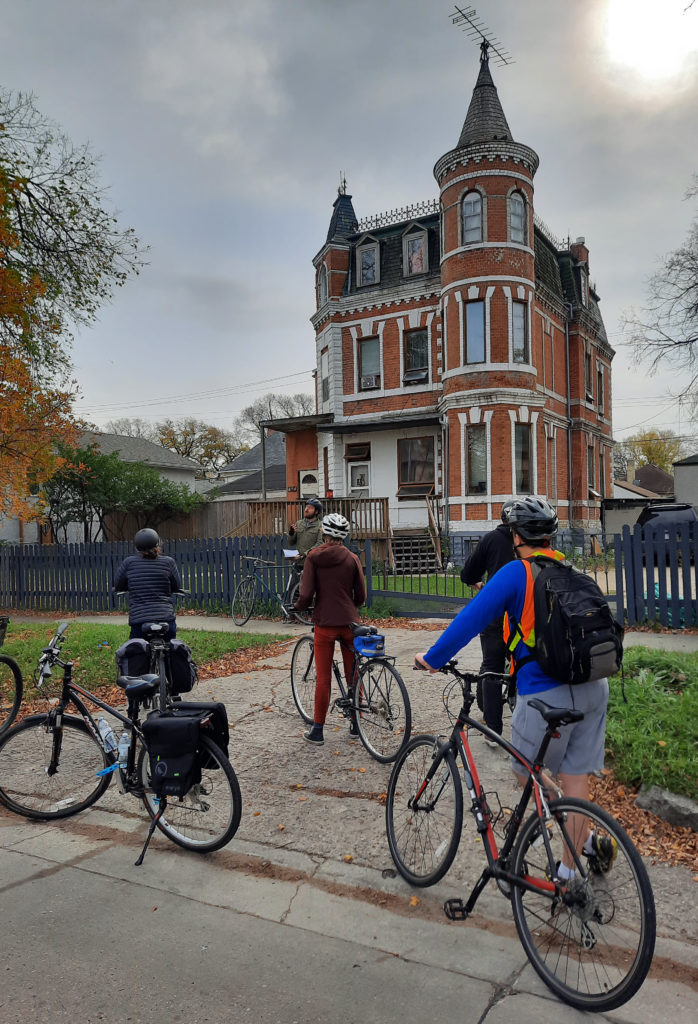
Biollo House was built in 1906 for a recently-retired Mayor of Winnipeg, who likely knew about the planned North End investments and service expansions. It was first rented to its designers/architects: The three Biollo brothers arrived as hotel investors who were quickly ruined, allegedly after crooked city staff refused to grant them a liquor permit. The house was later owned by a prominent Polish rabbi named Cantor, who published glowing letters describing Winnipeg in Polish newspapers and enticed almost 600 families to immigrate here. Locally known as “The Castle”, it used to have balconies on every floor, making it even more ornate than it looks today. It’s been described as one of the most spectacular family buildings constructed in Winnipeg before the First World War. It’s currently owned by a surgeon who immigrated from Vietnam, and is working on renovating it because it reminds him of palaces he had seen at home.
It’s an interesting example of a very ornate, over the top Queen Anne style building. This architecture was the height of eclectic Victorian taste. Rather than referring to a specific design style, Queen Anne buildings were almost like the “McMansions” of today. They mashed-together diverse and sometimes incompatible architectural styles and designs. They were often built for “new money” families that had made a name for themselves in what was still a frontier boom town.
This newfound wealth spurred development, and many newly wealthy immigrant families were looking to move out of the rough, commercial core of the North End. This led to a kind of “suburban” expansion north into the affluent rural community of St John’s.
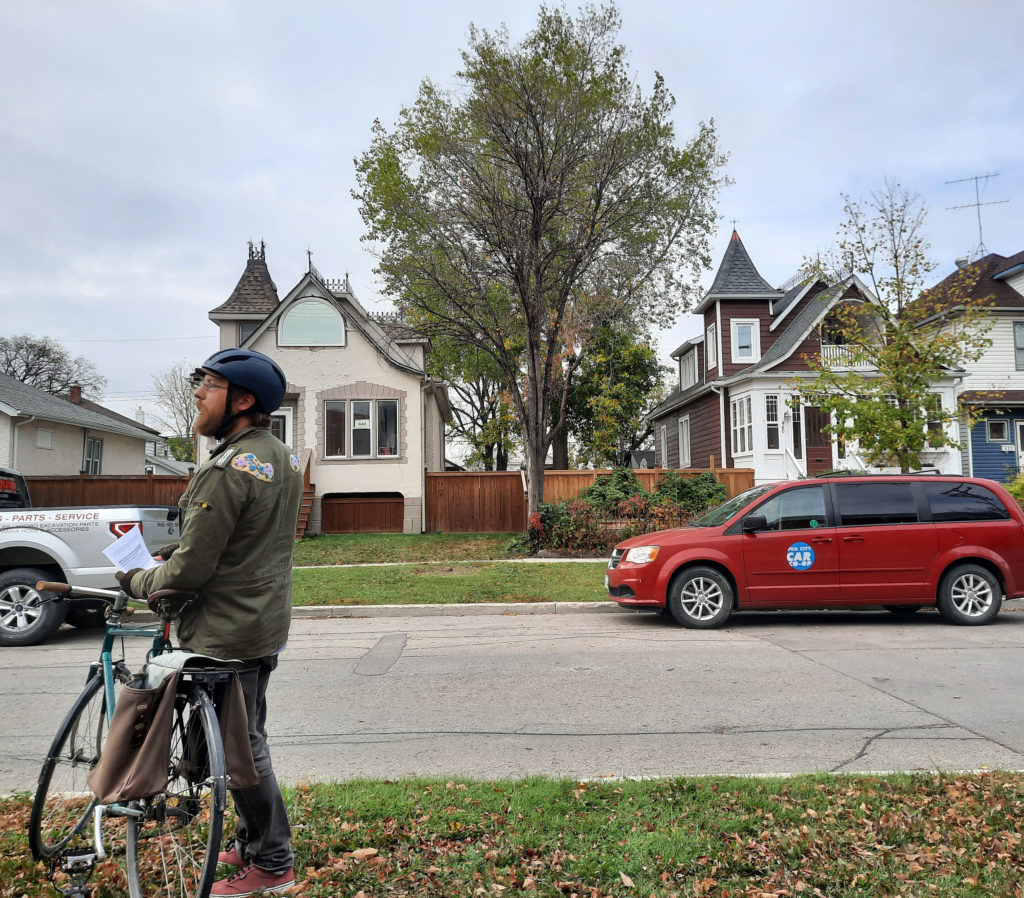
These neighbouring houses were built together in 1913, and are fascinating examples of eclectic architecture. They show us how two matching houses evolved over their lifetimes, picking up unique touches from the different families that occupied them.
They were never owned by anyone famous:
Diner House has far more changes from its original appearance, like the stucco exterior and the enclosed second floor. It was owned by a succession of handy-people: A carpenter, a decorator, and a welder. Taylor House retains its original look, and was owned by a life-long streetcar conductor.
This is a good reminder that we had electric transportation in Winnipeg shortly after 1900, including a fleet of electric street cars! The North Bus Depot (at Lansdowne & Main) was the end of the line for streetcar routes that ran from Downtown. We need to remind people that electric transportation is far from a new idea. If it was possible 120 years ago, we can return to more sustainable transportation.
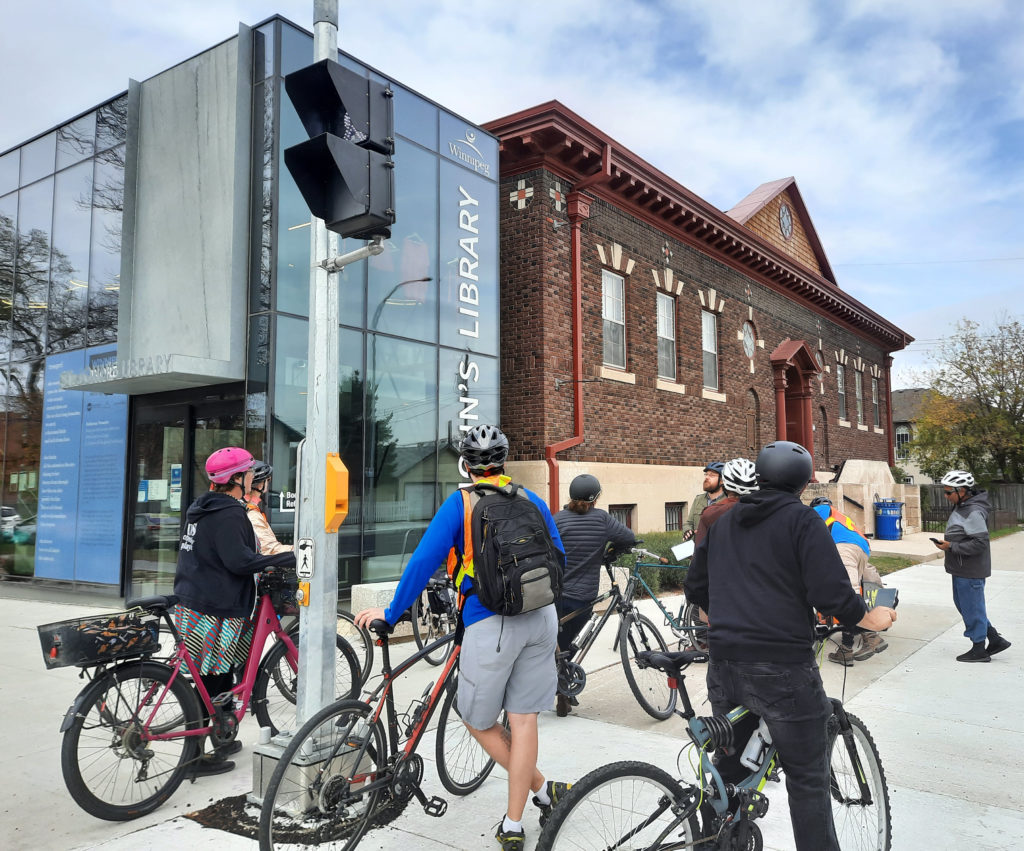
St. John’s Library was built in 1914 as a Carnegie library. An incredibly rich American industrialist named Andrew Carnegie dedicated his fortune to providing grants for cities, to allow them to build libraries. Winnipeg received several grants to build our first library and the Cornish Library, along with this structure.
Major renovations and adaptations were undertaken in 2019 to modernise and make the library accessible while still maintaining its heritage structure. This is a wonderful example of the adaptive re-use of our heritage buildings, rather than demolition.
While the building’s we’ve visited today date from the 20th century, St John’s is actually one of the oldest areas of Winnipeg, settled in 1812 by the first Scottish settlers. It remained rural until the early 1900s, as the city began to close in. Many of these settler families maintained large estates. Particularly in the area around St John’s Park & Cathedral, there was a very wealthy pocket of Anglo/Scottish families connected to the HBC’s fur trade that built large mansions. Many of these still remain on Scotia and St Cross – take a ride around and enjoy the sights!
The original site of St John’s School was nearby, along Main Street. Today we know this institution as St John’s Ravenscourt, a private school for the city’s elite. Over time the institution has simply followed the money south — as we have seen with many communities who first put down roots in this neighbourhood.
The Pedal into History project was supported by contributions from the Province of Manitoba through the Heritage Grants Program., the City of Winnipeg, and Seven Oaks House Museum. We are grateful for their support.

